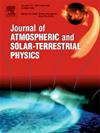Temporal variability of ozone and its precursors at tropical megacity, Bengaluru, India: Effect of volatile organic compounds and meteorology
IF 1.8
4区 地球科学
Q3 GEOCHEMISTRY & GEOPHYSICS
Journal of Atmospheric and Solar-Terrestrial Physics
Pub Date : 2024-12-01
DOI:10.1016/j.jastp.2024.106388
引用次数: 0
Abstract
Routine observations of surface ozone (O3) and its precursors (NO, NO2, NOx) were taken over Bengaluru, a southern megacity, India, for 4 years period between January 2015 and December 2018. The seasonal variations of O3, NO, NO2, and NOx have been analysed to understand the short-term variability of the pollutants at this site. The magnitude of O3 varied significantly by season, with maximum concentration during winter (13.07 ppbv) and minimum concentration during monsoon (9.52 ppbv). The highest concentration was observed in the post-monsoon season (17.38 ppbv) for NO, while NO2 and NOx showed the highest (41.75, 50.42 ppbv) in the winter season. The lowest concentrations of NO (5.70 ppbv), NO2 (30.43 ppbv) and NOx(36.28 ppbv) were observed in summer. An estimate was performed to determine the site's VOC-NOx sensitivity, using the TNMHC/NOX ratio as a photochemical measure. This ratio indicates that the study region is NOX responsive in all seasons. Analysis was done on the effects of meteorological factors such as temperature, water vapour, and ventilation coefficient on pollutants. Higher correlation of O3 with temperature showed the role of photochemical reactions in the formation of ozone and water vapour content leads to the removal of ozone concentration. The influence of meteorological variables on NO2 and TNMHC did not appear to be very significant. An analysis of CAMS data with real-time measurements of ozone and oxides of nitrogen showed that ozone is significantly correlated, while nitrogen oxides are not significantly correlated with CAMS data.
热带大城市臭氧及其前体的时间变率:挥发性有机化合物和气象学的影响
2015年1月至2018年12月,在印度南部大城市班加罗尔对地表臭氧(O3)及其前体(NO, NO2, NOx)进行了为期4年的常规观测。分析了O3、NO、NO2和NOx的季节变化,以了解该站点污染物的短期变化。O3的强度随季节变化显著,冬季浓度最高(13.07 ppbv),季风浓度最低(9.52 ppbv)。NO在季风后季节浓度最高(17.38 ppbv), NO2和NOx在冬季浓度最高(41.75、50.42 ppbv)。NO (5.70 ppbv)、NO2 (30.43 ppbv)和NOx(36.28 ppbv)浓度最低的季节为夏季。使用TNMHC/NOX比率作为光化学测量,对该地点的VOC-NOx敏感性进行了估计。这一比值表明研究区在所有季节都对NOX有响应。分析了温度、水汽、通风系数等气象因子对污染物的影响。O3与温度的相关性较高,说明光化学反应在臭氧的形成中起作用,水蒸气含量导致臭氧浓度的去除。气象变量对NO2和TNMHC的影响不明显。将CAMS数据与臭氧和氮氧化物的实时测量数据进行分析,发现臭氧与CAMS数据具有显著的相关性,而氮氧化物与CAMS数据的相关性不显著。
本文章由计算机程序翻译,如有差异,请以英文原文为准。
求助全文
约1分钟内获得全文
求助全文
来源期刊

Journal of Atmospheric and Solar-Terrestrial Physics
地学-地球化学与地球物理
CiteScore
4.10
自引率
5.30%
发文量
95
审稿时长
6 months
期刊介绍:
The Journal of Atmospheric and Solar-Terrestrial Physics (JASTP) is an international journal concerned with the inter-disciplinary science of the Earth''s atmospheric and space environment, especially the highly varied and highly variable physical phenomena that occur in this natural laboratory and the processes that couple them.
The journal covers the physical processes operating in the troposphere, stratosphere, mesosphere, thermosphere, ionosphere, magnetosphere, the Sun, interplanetary medium, and heliosphere. Phenomena occurring in other "spheres", solar influences on climate, and supporting laboratory measurements are also considered. The journal deals especially with the coupling between the different regions.
Solar flares, coronal mass ejections, and other energetic events on the Sun create interesting and important perturbations in the near-Earth space environment. The physics of such "space weather" is central to the Journal of Atmospheric and Solar-Terrestrial Physics and the journal welcomes papers that lead in the direction of a predictive understanding of the coupled system. Regarding the upper atmosphere, the subjects of aeronomy, geomagnetism and geoelectricity, auroral phenomena, radio wave propagation, and plasma instabilities, are examples within the broad field of solar-terrestrial physics which emphasise the energy exchange between the solar wind, the magnetospheric and ionospheric plasmas, and the neutral gas. In the lower atmosphere, topics covered range from mesoscale to global scale dynamics, to atmospheric electricity, lightning and its effects, and to anthropogenic changes.
 求助内容:
求助内容: 应助结果提醒方式:
应助结果提醒方式:


